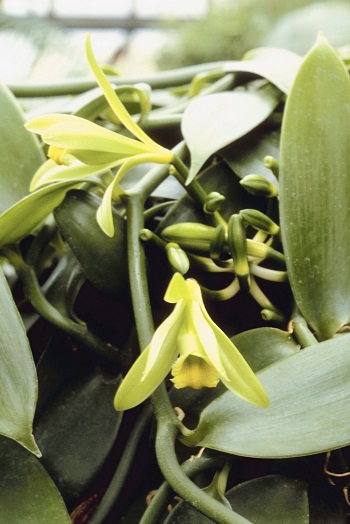
Out of the literally thousands of Orchids (of which new species are discovered regularly) there is literally only one specie that is not only edible, but also has a very valuable commercial commodity value as well.
Allow me to introduce Vanilla planifolia. Whether grown for its production value, as the Vanilla pod, or only simply as a collector’s plant, everyone should have one in their own collection. When in bloom the flowers are delightfully fragrant.
Vanilla planifolia is a tropical vine, with some variations in approximately 50 species that belong to a group that includes some of the most primitive orchids. The plant will naturally vine and climb using its leaves and short roots that typically attach themselves to tree trunks. The plant is found widespread throughout the tropics, especially Brazil, tropical Africa, and the West Indies. The flowers, which are produced from the racemes opposite each leaf axil are large and showy light green, are very short lived, but produced in succession. It is because of this characteristic of the short-lived flowers, that mechanical means of pollination must be used, i.e. pollinated by hand, a time consuming and laborious process. It is also because of the need for hand pollination of the flowers, that the Vanilla bean (pod) demands such a high price in the commercial market.
I personally found that the plant I grew in my own collection did so vigorously and decided the climb upon the highest supports of my redwood greenhouse. With plenty of light and vigorous air circulation it grew and grew but I simply could not convince it to bloom. After doing some research specific to the Vanilla and talking with other Orchid collectors, I discovered one odd, but sure way to make the plant bloom. I carefully removed the plant from the greenhouse rafters and literally “draped” it up and down upon the same support, creating sort of “ups and downs” or “hills and valleys” out of the vine. Not soon after (about 4 months) VOILA! out of each leaf axil, but only where the plant dipped down, came clusters of buds and eventually flowers! Truly remarkable! I meticulously hand pollinated each flower and eventually had my own supply of fragrant, plump, succulent vanilla beans!
I encourage everyone to grow this curious Orchid, it has the capability to give you so much in return!
Tom Capranica has been a hobby collector and hybridizer of Orchids for over 20 years, and an active member of the American Orchid Society for about the same length of time. He grows his Orchids in a 450 sq. ft. climate-controlled greenhouse, containing over 300 plants of various genera, primarily Cattleya.
Related Articles & Free Email Newsletter Sign Up
4 Popular Orchid Propagation Methods
A Quick Tutorial in Orchid Nomenclature or “Know Who You Have!”
To Pot or Not to Pot an Orchid, That is the Question!




Comment here